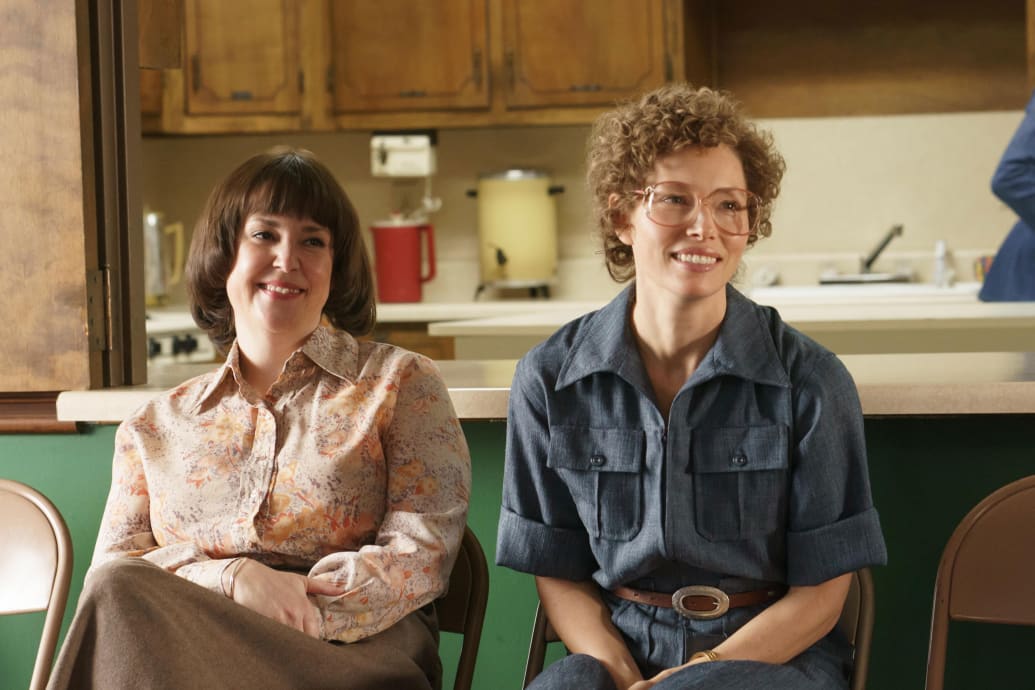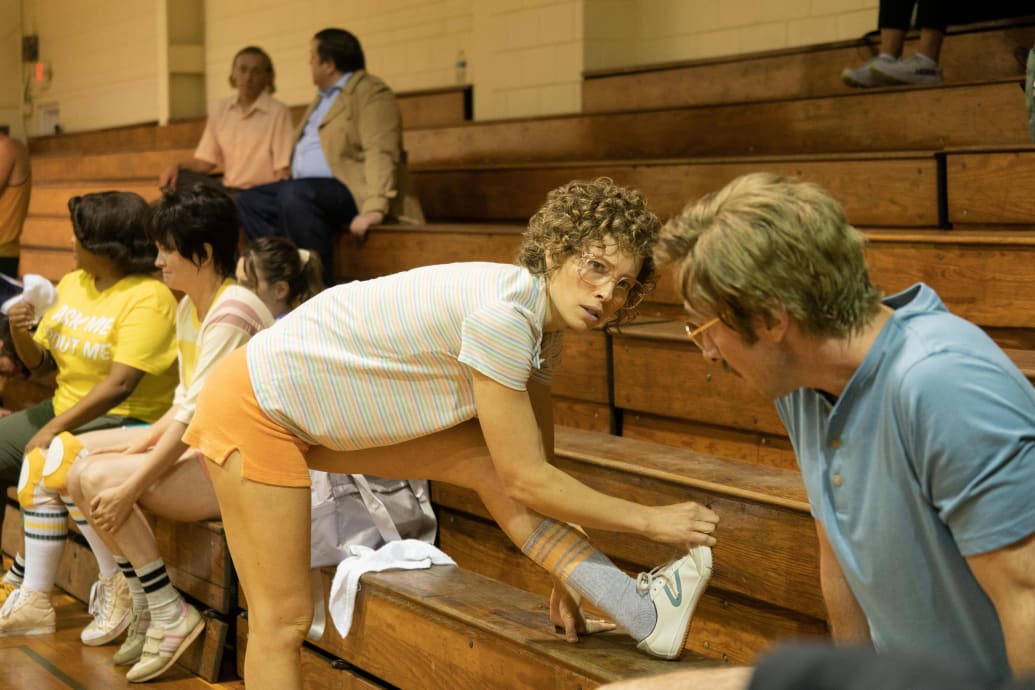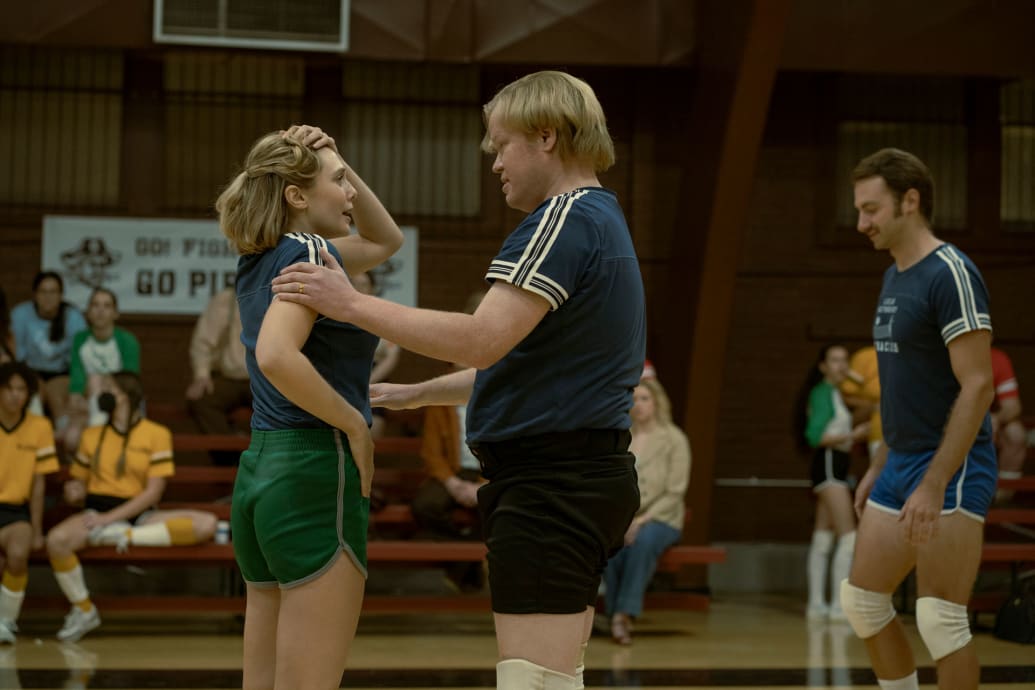When I first heard that there were two miniseries in production about the infamous housewife-turned-ax murderer, Candy Montgomery—one called , I became a true Biel-zebub.
My devotion is somewhat ironic—and I am constantly having my beliefs suppressed every time someone reminds me of the whole vax-lobbying thing—but it’s also completely genuine. Jessica Biel is Hollywood’s secret weapon; an unassuming, quiet talent, who does fantastic work with a meaty role (when she’s allowed to have one!). She was astounding in The Sinner, and her onscreen prowess in that series turned me on to Hulu’s Candy, which premiered this time last year.
While the five-part miniseries itself might’ve plateaued into a stagnant, by-the-numbers true crime story by its end, Candy was held up by Biel’s chilling turn as the real-life ax murderer who offed Betty Gore, the wife of the man Candy had an affair with, in 1980. Despite its faults, Biel remains consistently compelling as Candy. Biel has a particular knack for wearing an array of emotions on her face, all at once, which perfectly suited a housewife who felt suffocated by her own life. In any one scene, Biel could convey rage, fear, joy, confusion, and exhaustion in just a single look. And she could do it with a believable Southern accent, too.
There’s no denying that Olsen is quite good in her own take on Candy. She’s a pragmatic actress, who has managed to bring depth to a woman comic book character, something that is often not afforded to female superheroes and their ilk. But watching the first three episodes of Love & Death, which premiered on HBO Max this week, I found myself feeling like she was almost too good. In fact, Olsen’s often portraying Candy Montgomery like the actress is thrilled to have scenes to chew, well-aware that she’s doing a great job. Olsen is so natural as Candy that she feels unnatural; Love & Death doesn’t feel as much like a semi-fictionalized retelling of her story as it does a reenactment.


Candy
Tina Rowden/Hulu
This is most evident in Olsen’s performance of Candy’s accent, which sounds like she’s knee-deep in prep for the latest Tennessee Williams Broadway revival. There is not much public record of Candy’s real speaking voice, but Olsen’s lilting Southern inflection hops right over realistic to veer into parody. Meanwhile, the fellow Midwestern in me would like to attribute Biel’s excellent accent work to the native Minnesotan inside her allowing her to navigate vocal tone shifts, but I genuinely just think Biel understands the role a bit better.
I do hate to split (literal) hairs, but we must evaluate each incremental detail between these warring Candy crime collections: Why isn’t Elizabeth Olsen wearing a permed wig? Montgomery was famed for her tight tresses, up until she had them straightened for her trial. And yet, in the first three episodes of Love & Death, there is no trace of ammonium thioglycolate anywhere. I’m not saying that Olsen should’ve left her head to the hairdressers’ discretion; she surely has some sort of strict, written-in-blood clause in her Marvel contract about hair length (despite wearing a wig there, too!). But we couldn’t have dug out a hairpiece from the old HBO wig chest? Are perm wigs hard to come by, now that Ice Spice has repopularized the Annie? I’m desperate for answers, and if I don’t see at least one perm by the end of the series, I’m taking to the streets.
Of course, just resembling the person you’re playing isn’t everything. You can perfectly transform an actor, making them spend hours each morning in the makeup chair, and they still aren’t guaranteed to perform well, once the camera rolls. But something about Olsen’s Candy feels decidedly lacking in validity. Olsen’s natural charisma is working against her here, as does the series’ tendency to use that charisma as Candy’s sympathetic aid. Love & Death makes the character of Candy far too likable, and that’s a big issue, considering that Candy Montgomery’s self-defense plea got her an acquittal, despite striking her friend 41 times with an ax.

Candy
Tina Rowden/Hulu

Biel’s Candy, however, embodies the amount of surreality necessary for this strange story. It’s not every day that a housewife murders her friend in a sleepy Texas town, and Biel’s fittingly wiry energy gives her a masterful command of her character. She can turn Candy’s foreboding simmer of pent-up trauma and frustration on and off in an instant. And Candy allows her to do that, without overextending her or itself. Candy got its messaging across in five episodes, while still occasionally feeling too long. It’s a wonder that Love & Death needs seven, slow-building installments—especially when creator David E. Kelly’s signature glossiness ultimately hinders the production. Candy, on the other hand, was perfectly attuned to its late-’70s graininess and color palettes.
It’s worth noting that all of these comparisons are ultimately somewhat petty. Olsen has recently expressed that she and Biel bonded over their shared roles. “It was actually something that connected us,” Olsen said in the Wall Street Journal, “I was terrified, at first, of having the shows seemingly come out around the same time, and [Biel] really made that feel like not such a big deal.” And they’re both right: It isn’t a big deal. In fact, it’s a wonder that this thing doesn’t happen even more often, with Hollywood’s unnecessary penchant for true crime rehashes.
But while it may not be a big deal that there are two women playing Candy Montgomery within 12 months of each other, it does matter. Love & Death will get the last word (until another Candy Montgomery story comes along in 2028, surely), and Candy will be pushed back into the recesses of our minds, remembered as the first—and slightly less “prestigious”—of the two series. Us Biel Babes and Jessica Jammers won’t stand for that. Biel may not have been too good at making fudge, but she was fantastic when it came to creating Candy.



